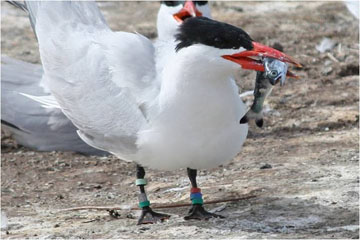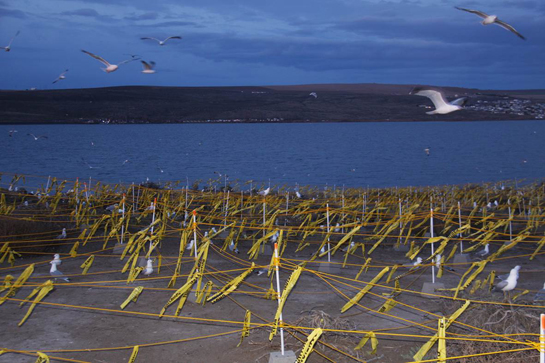March 2015 update: Grant County Public Utility District’s dams were not meeting their performance targets for juvenile steelhead and chinook survival, even though survival at the concrete was high, PUD assistant general manager Chuck Berrie told the Northwest Power and Conservation Countil last month. The PUD suspected that predation by Caspian terns in the tailrace of Wanapum and Priest Rapids dams was the culprit. Caspian terns nesting on nearby Goose Island were consuming 15.7 percent of ESA-listed steelhead smolts and 2.5 percent of ESA-listed spring chinook out-migrating from the upper Columbia River.
Action Agencies’ work to dissuade terns from nesting on Goose Island in 2014 (see story below) was a big help to the PUD. A big reduction in tern nesting helped reduce those predation rates to 2.9 percent for steelhead (a 12.7 percent decrease) and 0.3 percent for spring chinook (a 2.2 percent decrease). Even better news for the utility, total project survival (through Wanapum and Priest dams and reservoirs) went from 78.7 percent in 2010 to 89.3 percent in 2014.
“We could spend a lot more at the concrete and not increase survival,” said Berrie. “Focusing on avian predation is the single most important and cost-effective thing we can do to reduce the impacts on endangered species of fish.”
See Berrie’s presentation to the Council here.
The Corps and Reclamation are implementing the first phase of a five-year plan to manage tern predation in the Columbia Basin. The actions are part of the agencies’ January 2014 Inland Avian Predation Management Plan (IAPMP).
 | Starting at Goose Island early in 2014, Reclamation installed rope and flagging and began actively hazing the Caspian terns away from their usual nesting sites. On Crescent Island, the Corps is testing the effectiveness of willow plantings to deter Caspian terns. At the same time, the agencies will seek out a suitable location outside of the Columbia Basin and modify conditions there to make the area attractive to the birds for nesting sites. |
| Once the new habitat is enhanced, the agencies will move to the second phase of the plan – dissuading the tern colonies at both Goose and Crescent islands. Actions to dissuade terns on both islands would occur through 2018. |
Click here to see the phased actions in the Inland Avian Predation Management Plan.

Rope and flagging on Goose Island discourages Caspian terns from nesting.